
Haydock Place
Endeavour Cottage in Whitby located in the courtyard of Haydock Place.
At the end of Church Street leading out of the town is Spital Bridge which lead out of Whitby, its name coming from the leper hospital built in 1109 by the first Abbot of Whitby. On the river side are boat yards, where iron steamships were first built by the Turnbull family between 1871 and 1902. Church Street has long been associated with the jet trade. Jet workers were mentioned in 1394, and the 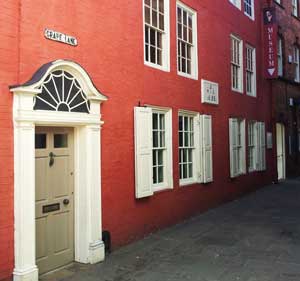 Romans used the material for ornaments.
Romans used the material for ornaments.
Sandgate, which leads from the Market Place to Bridge Street, still has many tourist shops and old fashioned sweet shops. It dates from 1401, and the old market hall is now a clothing factory. In Charles II’s time, the Customs House was the scene of rioting when contraband was being taken in by armed guard.
Captain Cook Museum on Grape Lane
Opposite the end of Sandgate, across Bridge Street, is Grape Lane (from "Grope", the street being dark), a narrow thoroughfare once having buildings on both sides.
Demolition has now given space for cars at the Church Street end. Backing on to the harbour is an old house which was formerly the Whitby Old Bank. Because of banking interests, this street was once known as "Lombard Street". The house contains fine period woodwork, as does the one next door which now bears a plaque mentioning Captain Cook. Dated 1688, it has an attic in which Whitby’s famous son is said to have slept when lodging with John Walker, the Quaker ship-owner, who made Cook his apprentice.
At the corner of Grape Lane and Bridge Street is the Whitby Gazette, the town’s old established weekly newspaper founded in 1854. The building was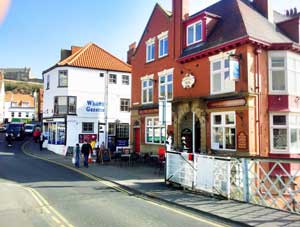 once an inn. And so to the bridge, a focal point for visitors who rush here on hearing a ship’s siren or the warning bell, and watch vessels negotiate the narrow passage to the upper harbour. In summer, long queues of cars build up and masses of people surge across when the gates are re-opened. A high level bridge across the valley was suggested in 1866 by Francis Pickernell, engineer to Whitby Harbour, but nothing came of it.
once an inn. And so to the bridge, a focal point for visitors who rush here on hearing a ship’s siren or the warning bell, and watch vessels negotiate the narrow passage to the upper harbour. In summer, long queues of cars build up and masses of people surge across when the gates are re-opened. A high level bridge across the valley was suggested in 1866 by Francis Pickernell, engineer to Whitby Harbour, but nothing came of it.
A 14th century wooden bridge was replaced in 1610, but this was frequently damaged by ships colliding with it, and in 1766 a draw bridge on stone piers was built. A swivel construction replaced this in 1835, and survived until 1909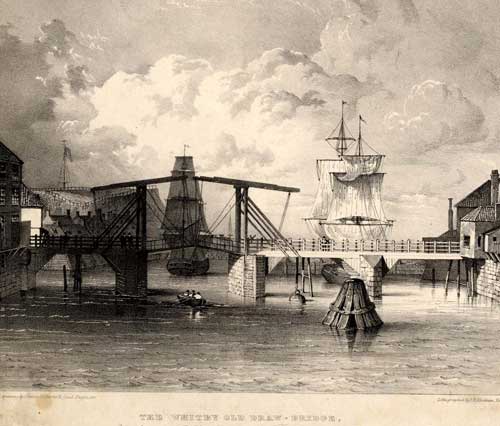
when the present electrically operated bridge, cared for by the town council instead of the county, was built. Outside the control house is a weather gauge and a notice giving times of the tides.
Tweet - FB Like Us or G + Us..
From the east side of the river once known locally. as `"across t’watter", we cross the bridge into another old Market Place, from which lead Baxtergate, Flowergate and St. Ann’s Staith. Weekly markets were held here from 1445 to 1640. The Golden Lion Inn is an ancient establishment, and was honoured by becoming the first Masonic Lodge in 1764. St. Ann’s Staithldates from 1499, the present quay being eight feet higher than a previous one which had a row of houses, supported on piles backing on to the harbour. The narrow passage, which leads from the Staithside next to the shop that was for many years Woolworths and up to Flowergate, is now St. Ann’s Lane but was once Hell Lane. It led to a ford across the river connecting with Sandgate.
At the seaward end of the staith is Haggersgate, twisting off to the left. The Missions to Seamen building on the corner was built as a private house in 1817. In 1965 a new recreation room was created inside, resembling a ship, with a huge mural painting depicting the east side of Whitby, In this street, which is on a sandbank with buildings supported by piles, was a jet ornament factory, The street opens into "Coffee House End", where there was once the fish market, and a building formerly used as a museum.
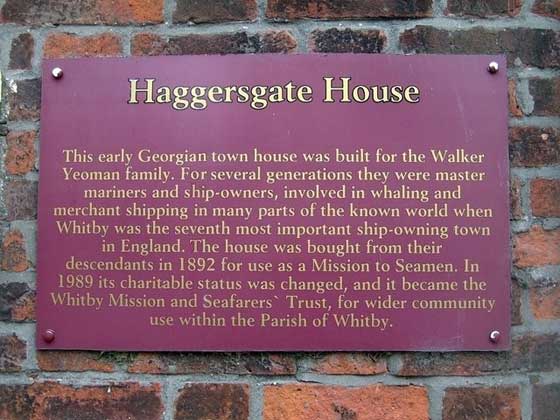
Now comes the modern fish quay, built in 1957, a busy place early in the day as the keel boats and cobles unload their catches and the auctioneer sells the iced boxes to groups of men who say little but nod occasionally. Wagons load up here, boxes pile up, crab pots are stacked, nets spread. A man with a hose swills away the fish scales, and the gulls swoop down for dropped fish. The tall tower spills ice down a chute to the boats tied up under the quay wall. Engine fuel is stored under the pier. The old buildings still with coloured tiles and crooked chimneys have new fronts, and the Bingo callers vie with the fishing port noises and the screaming gulls.
Haggersgateextends to the bandstand at Scotch Head, and to the Battery 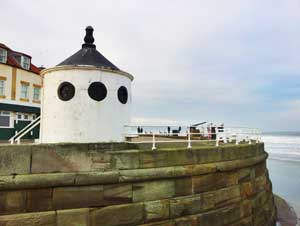 Parade with the old coastguard station. The half-moon battery has exchanged its guns for seats. The West Pier, originally of timber, was rebuilt in 1814, and Francis Pickernell, the Harbour Engineer, designed the 83ft. tall lighthouse with its fluted columns in 1831. The distance from the Bridge to the Pier End is 795 yards.
Parade with the old coastguard station. The half-moon battery has exchanged its guns for seats. The West Pier, originally of timber, was rebuilt in 1814, and Francis Pickernell, the Harbour Engineer, designed the 83ft. tall lighthouse with its fluted columns in 1831. The distance from the Bridge to the Pier End is 795 yards.
Battery Parade
The smaller lighthouse (54ft.) on the East Pier was built in 1854. Both towers, along with the beacons, have fixed lights, the beacons burn continuously, whilst showing green and east showing red. The west lighthouse is worked manually, when vessels are expected, to indicate it is safe to enter harbour. In daylight a black ball is hoisted outside.
The east ligh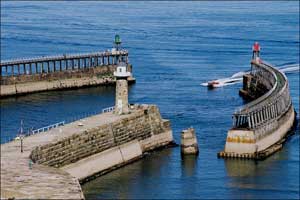 thouse, which had a divided red and green light, has had the red replaced by a red lamp on the Church Stairs indicating when a vessel is entering on an unsafe bearing. The west pier extension use to have has a foghorn which sent out blasts every 30 seconds in fog.
thouse, which had a divided red and green light, has had the red replaced by a red lamp on the Church Stairs indicating when a vessel is entering on an unsafe bearing. The west pier extension use to have has a foghorn which sent out blasts every 30 seconds in fog.
Whitby Guide History of the Streets and Buildings Intraduction
Whitby Guide History of the Streets part two Church Street
Whitby Guide history of the streets and buildings intraduction
History Of Flowergate in Whitby
Whitby History part 1 Whitby Bridge, Grape land and Tin Ghaut
Whitby History part 2 Church Street, Scoresby House, Bowlby Bank, Abbey House and St Marys Church
Whitby History part 3 Henrietta Street Fortunes Kipper, the Bllck Horse and the White Horse and Griffin
Whitby Guide history of the streets and buildings part one intraduction
Whitby Guide history of the streets part one Church Street
Whitby Guide history of the streets part three St Anns Staith to the Piers
Whitby Guide History of the streets part four from Khyber Pass to Baxtergate

Endeavour Cottage in Whitby located in the courtyard of Haydock Place.

Across the rooftops of Whitby towards the abbey

A view of Whitby Abbey from a cottage window.

We could provide high occupancy.
Want more booking for your holiday accommodation?
List your property with us. no contract red tape, no setup fee. Just bookings if and when you want them.
Whitby Holiday Cottages Letting Agency.